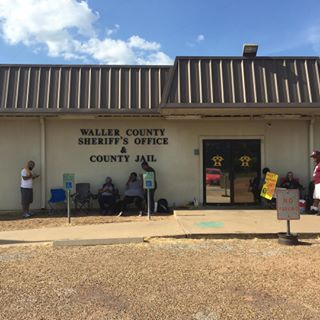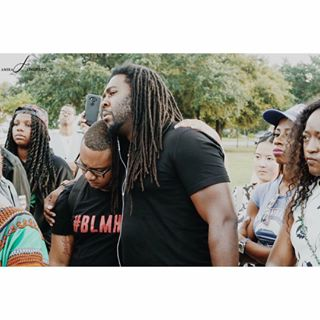F&A Series: 'On Faith as Activism in Black Lives Matter'
Biko Mandela Gray is Assistant Professor of American Religion at Syracuse University. He teaches on race, identity, and religion in the United States, and his research interests are on subjectivity, ethics, and race in the study of religion. Follow him on Twitter: @BikoMandelaGray
They found her, hanging. Unable to make bail, unable to fund her own freedom (in ways eerily reminiscent to the history of chattel slavery in the United States), Sandra Bland was found hanging in a jail cell just three days after she was brutally subdued and arrested for allegedly “assaulting” a police officer following a minor traffic violation.

It was in July 2015. We got the news shortly thereafter. Well, Rhys Caraway, a gay black man living in Houston, got the news first. And, by the grace of his God, Rhys extended a tradition of black activism by holding a vigil in front of the Waller County jail. This vigil, in the spirit of legendary black queer activists such as Bayard Rustin, Audre Lorde, and so many others, was the beginning of Black Lives Matter: a movement led by black, mostly queer-identifying people, searching for justice.
The vigils began as a way to honour “Sandy,” to let everyone know that she mattered—that she matters. Leaving early every morning to make the hour-long commute to Waller County, Rhys allowed his faith in his God to raise awareness. Vigils can be powerful. They can do more than remember; they can—and in Rhys’s case, they did—raise awareness about the injustices that cause us to remember, that forces remembrance upon us too soon.
Rhys’s activism invited others. We came. First, in ones and twos, and eventually in tens. A rally was held. And then another one. And in each case, the collective voice got stronger, louder, more potent; national newspapers wrote about Sandra Bland. And then a documentary was made (there was no mention of Rhys’s inaugurating work, but that’s how white heteronormativity operates). Bland became one in a long line of recent martyrs sacrificed at the altar of white supremacy in the United States. Rhys may not have been on the front page of every article. He, and us, weren’t in it for the publicity. We were there to ensure that Sandy wasn’t forgotten. She isn’t forgotten.
Making daily pilgrimages to Waller County, Rhys Caraway—guided by his faith—used a ritual of remembrance as a tool of and for activist consciousness-raising. He wasn’t alone. But I centre him here to show how one’s religious identity opens the possibility for thinking about religion more expansively, for showing how “faith”—if such a term is to be retained—can be an engine for imagining new possibilities, new strategies, and new tactics for pushing change. Rhys’s faith helped to further galvanise an already growing movement.
And, in fact, Rhys’s faith helped us to understand a different meaning of faith itself.
***
The term faith often invokes a Protestant heritage: mustard seeds, constipated reformers, and self-deprecating theologians pepper the term’s history, suggesting that faith is something that has to be connected to salvation (as traditionally understood, as saved from sin and eternal damnation).
But what if faith meant something different? What if faith was not (merely) organised around being saved by a vindictive, violent, and virulently jealous God, but instead was a call to something, a motivator for action? I began this post with Rhys, with his faith, because I want to show how faith can do more than secure one’s salvation (whatever that term may come to mean). I started with him to show that faith can and will create change—not simply in one’s internal state, but instead to announce that there are, as Ashon Crawley has written, “otherwise possibilities” right here in the present. Rhys may have moved on the basis of his faith in his God, but that faith motivated him to creatively and communally open a space for remembrance that became a space for justice.
This, of course, isn’t new. Even the most superficial accounts of black activism in the United States tell a story about how faith galvanised the possibility for change. Martin Luther King, Jr. infused his activism with his training in Boston personalism; Malcolm X began his activist journey through an engagement with the Nation of Islam. Fannie Lou Hamer drew from her faith to galvanise voting rights activism, and Cornel West’s entire philosophical and activist legacy stems from what he calls a “prophetic” call to do justice informed by his own sense of radical Christianity. It’s always been there.
But these figures—and the faith they carry—show us that faith can have many possibilities and manifestations. This is precisely what Patrisse Khan-Cullors gets at in her memoir When they Call you a Terrorist:
It’s the faith that drove us to run without maps or compasses, money or friends, with dogs trained by demons following behind. It’s the faith that sent four Black students, on February 1, 1960… to sit down at a “whites-only” lunch counter at a Woolworth’s… and refuse to move, risking bodily harm and their very lives. It’s the faith that allowed Robert Parris Moses to keep pushing for voting rights in the deep South in 1965 despite only being able to register one Black man that first summer in Amite County, Mississippi (Khan-Cullors, 2017, 127).
Faith, then, takes us not simply to God and the gods. It also announces a commitment to achieving the seemingly impossible, to seeing what cannot be seen, and acting in kind. To have faith, then, can mean more than securing one’s salvation. Faith might—and in the case of Rhys and the Black Lives Matter movement more generally, faith does—mean committing oneself to freedom, to the possibility of freedom in a world where freedom is denied, where freedom is always and already under threat. In other words, faith might mean committing to what’s impossible, given the circumstances.
I have claimed elsewhere that what makes BLM (and its previous incarnations) significant is that the movement makes a commitment to achieving the impossible. The faith that BLM expresses is a faith that does not need God or the gods, but instead expresses a commitment to blackness itself as sacred. In so doing, BLM troubles us, asking us to think differently about faith—and religion more generally. What if “religion”

is happening in the midst of resistance movements? What if religious possibilities are experienced within the context of political pushback? If this is the case, then we might want to look at these resistance movements—I study Black Lives Matter as one—as religious movements, as religious possibilities operating in “secular” spaces in ways that trouble our distinctions and our categories.
In short, maybe Black Lives Matter has much to teach us in the study of religion. Not by way of Protestantism or established traditions, but instead by troubling what “counts” as religious in the first place.
If, as the Bible says, faith is “the substance of things hoped for, and evidence of things not seen,” then maybe BLM is the enactment of a radical hope and an invisible—and seemingly impossible—goal. Indeed, one might say, it is the enactment of salvation.
Or at least that’s what Rhys taught me.
Written By: Dr Biko M. Gray
In-text Image Credits: Dr Biko M. Gray
Feature Image Credit: Robert Fairchild @flickr
